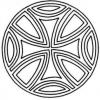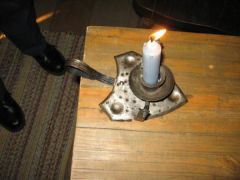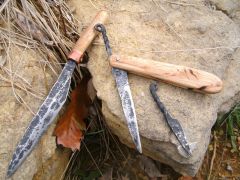-
Posts
539 -
Joined
-
Last visited
Content Type
Profiles
Forums
Articles
Gallery
Downloads
Events
Everything posted by Tim McCoy
-
For Christmas I get 220 service installed in garage this week! Sparks at last :lol:
-
IMHO anvils, like women need, a certain amount of finesse when being dealt with. How I treat mine is my business (short of violence) and if it works for me whose to say, "that's wrong"? Bolt it, drill it, weld it and most of us will consider that violence. It's yours, but keep in mind that, unlike women, you can still sell your anvil someday and unless you want to have a junker - don't lay a welding rod to it or drill holes in it. Treat her with consideration and act like you care about her and someday, if you haven't marked her up, she'll still be valuable and you will be happier. Tim
-
Bentiron, Came back late to see how things were going for you. Glad to see that you're moving forward and getting a handle on the weight thing. All natural food is good for us, but in moderation as you have learned. Many of us have learned late in life that it's about the journy. So, discovering more about how we can handle our faults and frailties is a God Send for sure. Your willingness to share and to express your faith is a support for many of us here too. I have to lose 100#. Like you said it doesn't represent having too many apples I hope that you continue to improve and somehow the pain you are in becomes more and more managable. God loves you! Tim McCoy
-
Those that I have seen work well. One end is usually attached semi pemanantly ... the other end has a wieght on it. Once the piece you need to smack is laid on the anvil the timing chain is draped over the work piece and the links allow for a reasonably secure hold down. Regular chain can work also.
-
Forging a post vise can be beyond the means of the average back yard blacksmith working alone. Nevertheless, go to this link to see how one can be built by anyone with some tools and a good eye for scrounging: http://www.abana.org/downloads/education/VerticalVise.pdf . . . guess it depends if you need a working vise or an "authentic post vise". There are more examples on the internet. I would check with some of the existing blacksmith organizations. Seems to me that I have seen a couple of other examples of self built vises at those sites. Also, go to the "Show Me Your Vise" section of this forum and you will find at least two shop made vises that will handle most blacksmith work. Have fun! Tim
-
Saw a 2 oz. ball pien hammer at a yard sale once ... guy said his dad was a clock maker.
-
It's always the little touches that make things so different - your idea about a fold over the leading edge is really brilliant! Thanks for sharing.
-
-
First of all let me put in some disclaimers here for sharing a posting on You Tube from Jim Poor ... I wouldn't do this at home or anywhere else! And forgive me, but I think that this goes right up there with the topic I started about the Asian guy with the paper welding mask ... stay with it, wait for it and then let me know where the sledge goes Tim McCoy
-
While letting Christmas dinner settle in I ran across this 6 part series about ornamental iron work. Here's a link into the series. It includes rebuilding a Yellin Gate in 1987 ... perhaps you have not seen it yet. Enjoy and Happy New Year!
-
Just for yuks - here's yet another way to build an anvil stand...
-
Thanks for sharing!! Seeing these items should reassure all us of to never be hesitant to ask for the money that pays us for what we do. My son is an industrial/commercial architect. His clients willingly pay what seems to be outrageous prices for "just the right" piece to use as an accent for a room or display. There is seldom any quibling about the $$$ involved if the work done on the piece reflects an attention to detail - what we call craftmanship. What are the possibilites for us to create usable/saleable stuff that mimicks older pieces??
-
I found a great reference book at the library today: Encyclopedia of Antique Tools & Machinery by C. H. Wendel ISBN: 0-87341-607-4 Published by Krause Publications Copyright 2001 255 pages ... over 1,000 reproductions of old catalog illustrations of tools/equipment - black & white and some color photos. I found this book to be a treasure trove of information regarding tools and equipment that date from before 1925. Divided in to 14 alphabetical sections listed by types of tools and/or areas used such as blacksmithing or bee keeping and surveying. Illustrations of each item are taken from period specific catalogues. Many of the tools shown can be made by blacksmiths such as beading tools used for fluting coach bodies or 4 way cross wrenches for tightening nuts on tire bolts for wagons. Of special interest for IFI members would be the sections on Adzes, Picks and Mattocks; Blacksmithing; Carriage and Wagon Making tools; Chisels; Post Drills; Farrier Tools; Grindstones & Grinders; Hammers ... the list goes on. There are no instructions about manufacturing, but many of the illustrations should be more than helpful for understanding completed products. How many of us have actually seen a "Boilermakers Riveting Hammer", a "Carriage Ironer's Hammer", a "No. 20 Champion Grinder" or an "Edwards No. 5 Shear" (built in 1895 and capable of cutting a 4 x 1/2" bar)? For those of us who have an abiding interest in all things related to tools and for those wanting to do reproduction/repair work on older tools this is a great resource. It can also be a source for identifying many tools that have passed into the "Whatzit" phase. There is even a section on Railroad Tools. Included in that section is an illustration of two railroad track levels made by the Buda Company out of Harvey, Illinois. I do not know if this book is still in print, but you may search for it online or simply check with your local library to see if they can order one for you to check out on a lending program. On page 212 there is an illustration of two Diston hacksaws made especially, "For cutting rails, girders, and other heavy pieces ..." they used an 18" blade and came with single or double handles. So, whether you need information on Alligator wrenches or Cornice hammers for working copper, this book is a great resource.
-
Merry Christmas to all of you from rainy Las Vegas!
-

Old blacksmithing videos about to be removed...
Tim McCoy replied to Grafvitnir's topic in Blacksmithing, General Discussion
Imagine that, a flat steel bar, a tiny post anvil, an old hammer, some charcoal, a skin bellows, a couple of punches and chisels and a helper and who knows how much practice and your a blacksmith. Even as a novice I feel confident believing that these guys could stand shoulder to shoulder with most "modern" backsmiths. They just don't have any tools newer than the 9th century, but they got the know how. It's almost poetic. At the end you could see that they were proud of their work. Every newbie should see the video of the two guys in the Sahara. It's only about what you know how to do ... any tool, any metal, anywhere and you can make things if you have some skill, determination and patience. It is about the craft, not the tools. It's not hard to imagine other men from the Far East or Northern Europe doing the same things 11-1200 years ago. Seeing this video makes it much easier to work in my little 6 x 6' homebuilt shed with a borrowed anvil, a cheap rivet forge, hand cranked blower, used hammers, scrounged metal and some charcoal. I have so much more than these guys have in the way of equipment. All I need now is a lotta practice and to not worry about what other people have to work with. I have no tool envy now. I just need to practice, practice, practice. Thanks for sharing! -
For those that care about rebar and it's characteristics check out this link http://en.wikipedia.org/wiki/Rebar ... specs, grades and other useful information. Hope this helps those who are seeking straight answers about rebar. Many people regard rebar simply as just another steel product, consequently it is used for "everything" that steel can do. How many of us have seen or used rebar as struts, connectors, braces, knives, prybars and fencing and so on. It is often pushed way beyond its intended use. While it works in many creative uses it is still only metal of questionable composition that is meant to provide tensil strength for concrete. Any other usage is done at the users risk. IMHO Steel that has a pedigree (a definable composition and perhaps a certifiable set of all around characteristics) will make products that will not embarass the producer. Otherwise, it is often free as scrap anywhere there is some kind of construction so go pick up all you can and beat it hot & hard while you learn. Tim
-
-
You have done a wonderful job ... congrats!!
-
Has anyone noticed how close the site is to breaching the 200,000 post barrier??? WOW - that should be quite a day when that happens ... congrats to Glenn and all the rest of those who have helped keep this thing going! How about a free t-shirt to the member that puts it over the top???
-
Tremendous - it's like a Where's Waldo picture ... too much to take in at one viewing! I'd just like to here the story behind the andirons setting out front.
-
Just wonderful! A treasue trove for all of us to use. Thanks :D
-
Welcome - you will find this more than an addiction and there is no end to the help to be found here.
-

"The Blacksmith's Cookbook"
Tim McCoy replied to Thomas Dean's topic in Blacksmithing, General Discussion
This book is available in the Las Vegas, NV library to read anytime you want it ... I don't think they believe it is worth $500.00 I have checked it our several times. -
Hey ThomasPowers ... Please send me a PM please tried to send you one but it said you couldn't receive. I want to update my understanding of thermocouples ... check this out first http://en.wikipedia.org/wiki/Thermocouples sorry for highjacking the thread Tim
-
Thanks again guys ...


